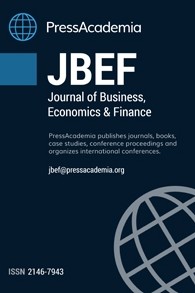Internal Audit Positioning - Four Stage Model
Internal Audit Positioning - Four Stage Model
The objective of this paper is to introduce a new model about positioning of internal audit. There are only a few studies about this subject. Studies about positioning of internal audit function are made for individual research subject such as internal audit’s position in public companies, in private companies, in big firms, in a country, etc. However, there are not many models which show dynamics of internal audit function with a macro approach for positioning as to its maturity, skill sets, independence and governance for private industrial companies. The positioning model outlined in this paper aims to contribute to literature by providing a generic guideline and a tool for assessing the position of any internal audit function and to increase the awareness among stakeholders; thus, motivate decision makers of Turkish organizations to interrogate and challenge what they should be expecting from internal audit function. It will also help the Chief Audit Executives to make more effective audit planning, budgeting, staffing, training, and execution
___
- Ahmad Z., Taylor D. (2009). Commitment to Independence by Internal Auditors: the Effects of
- Role Ambiguity and Role Conflict, Managerial Auditing Journal, Vol.24, Iss: 9, pp.899-925
- Berry R. (2012). 3 Keys to Being a Top Performing Auditor, That Audit Guy web-site article, available online at http://www.thatauditguy.com/author/robert-berry/
- Chambers R. (2010). Looking Ahead to 2011: What Does It Hold for Internal Auditing, the IIA website article, posted December 15, 2010, available on line at: http://www.theiia.org/blogs/chambers/index.cfm/post/Looking%20Ahead%20to%202011:%20Wh at%20Does%20It%20Hold%20for%20Internal%20Auditing
- Christopher J., Sarrens G. and Leung P. (2009). A Critical Analysis of the Independence of the Internal Audit Function: Evidence from Australia’, Accounting, Auditing & Accountability Journal, Vol: 22, pp.200-220
- Christopher J., Sarrens G. and Leung P. (2007). An Exploratory Study on Internal Audit
- Independence in Australia’, AFAANZ Conference, July 1-3, 2007
- Deloitte (2009). The Changing Role of Internal Audit, available on line at: http://www.deloitte.com/view/en_BE/be/services/aers/internalaudit/efeb39896dea7210VgnVCM1 00000ba42f00aRCRD.htm
- Ensel E., O’Neal E., Stelzer M., Testa D. (2012). KMEF Knowledge Functions and Competencies,
- Institute for Knowledge and Innovation Education Forum Annual Summit, the George Washington University Ernst & Young (2009). Metamorphosis (Part 2): Assessing the Maturity of Your Internal Audit
- Function, available on line at: http://www.ey.com/Publication/vwLUAssets/Metamorphisis_II:_Assessing_the_maturity_of_your _internal_audit_function/$FILE/Metamorphosis_Assess_Maturity.pdf Hudaib M., Haniffa R. (2009). Exploring Auditor Independence: An Interpretive Approach,
- Accounting, Auditing & Accountability Journal, Vol.22, Iss: 2, pp.221-246
- Johnson S. (2012). Do Your Internal Auditors Have the Right Skills? CFO.com article, available online at http://www3.cfo.com/article/2012/4/auditing_internal-audit-skills
- IIA Australia (2010). Internal Auditor Competency Framework, Australia, available online at: http://www.iia.org.au/Libraries/Learning_Development/Internal_Audit_Competency_Framework. sflb.ashx
- IIA Research Foundation (2010). Core Competencies for Today’s Internal Auditor, Altamonte Springs, FL
- Lipchak A. (2002). Evidence-based Governance in the Electronic Age: A Summary of Key policy
- Issues, The International Records Management Trust, UK Neelakantan K. (2011). Internal Auditing – Shifting from ‘Inspection’ Mode to ‘Advisory’ Mode,
- Morison Menon website article, available on line at: http://www.morisonmenon.com/internal- auditing-shifting-from-inspection-mode-to-advisory-mode.php Nissley E. (2011). Core competencies for Today’s Internal Auditor, The RMC Advisors (Risk,
- Management, Control) web site article, available online at: http://www.thermcadvisors.com/2011/01/core-competencies-for-todays-internal-auditor.html
- Protivity (2009). Guide to Internal Audit / Frequently Asked Questions About Developing and Monitoring an Effective Internal Audit Function, 2nd. Edition, available on line at: http://www.intellityconsulting.com/recursos/recurso/GuideInternal_Audit-FAQs-2n_Edition.pdf
- PwC (2012). Internal Audit 2012, A Study Examining the Future of Internal Auditing and the Potential Decline of a Controls-centric Approach, available on line at: http://www.pwc.com/sg/en/advisory/assets/publication-internal-audit-2012.pdf
- Ridley J. (2009). Starting a Successful Internal Audit Function to Meet Present and Future
- Demands, QFINANCE website article, available on line at: http://www.qfinance.com/auditing- best-practice/starting-a-successful-internal-audit-function-to-meet-present-and-future- demands?full Stewart J., Subramaniam N. (2009). Internal Audit Independence and Objectivity: A Review of
- Current Literature and Opportunities for Future Research, Griffith University, Griffith Business School, Discussion Papers Accounting. Tapestry Networks (2011). Internal Audit’s Evolving Role: A Proactive Catalyst of Business
- Improvement. Insights for North American Audit Committee Members, Ernst & Young, available online at http://www.tapestrynetworks.com/upload/Tapestry_EY_ACLN_InSights_Apr11.pdf. The Institute of Internal Auditing Research Foundation (2009).Internal Audit Capability Model
- Model, PwC web site article posted on October 2012, available on line at: http://www.pwc.lu/en/press-articles/2012/enhancing-the-internal-audit-function.jhtml. http://www.theiia.org/ Website of the Institute of Internal Auditors, the Professional Practices
- Yayın Aralığı: Yılda 4 Sayı
- Başlangıç: 2012
- Yayıncı: PressAcademia
